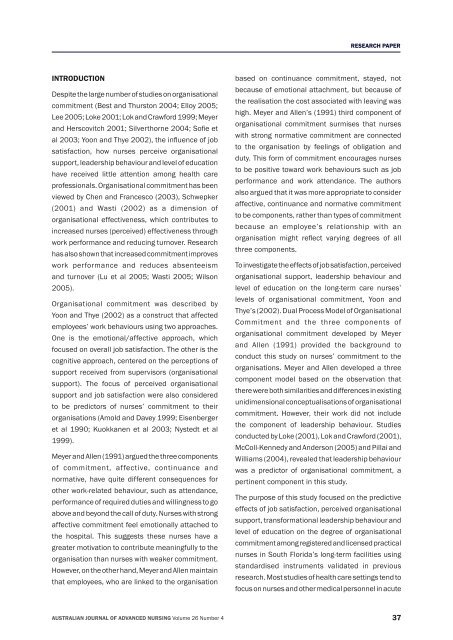australian journal of advanced nursing
australian journal of advanced nursing
australian journal of advanced nursing
You also want an ePaper? Increase the reach of your titles
YUMPU automatically turns print PDFs into web optimized ePapers that Google loves.
INTRODUCTION<br />
Despite the large number <strong>of</strong> studies on organisational<br />
commitment (Best and Thurston 2004; Elloy 2005;<br />
Lee 2005; Loke 2001; Lok and Crawford 1999; Meyer<br />
and Herscovitch 2001; Silverthorne 2004; S<strong>of</strong>ie et<br />
al 2003; Yoon and Thye 2002), the influence <strong>of</strong> job<br />
satisfaction, how nurses perceive organisational<br />
support, leadership behaviour and level <strong>of</strong> education<br />
have received little attention among health care<br />
pr<strong>of</strong>essionals. Organisational commitment has been<br />
viewed by Chen and Francesco (2003), Schwepker<br />
(2001) and Wasti (2002) as a dimension <strong>of</strong><br />
organisational effectiveness, which contributes to<br />
increased nurses (perceived) effectiveness through<br />
work performance and reducing turnover. Research<br />
has also shown that increased commitment improves<br />
work performance and reduces absenteeism<br />
and turnover (Lu et al 2005; Wasti 2005; Wilson<br />
2005).<br />
Organisational commitment was described by<br />
Yoon and Thye (2002) as a construct that affected<br />
employees’ work behaviours using two approaches.<br />
One is the emotional/affective approach, which<br />
focused on overall job satisfaction. The other is the<br />
cognitive approach, centered on the perceptions <strong>of</strong><br />
support received from supervisors (organisational<br />
support). The focus <strong>of</strong> perceived organisational<br />
support and job satisfaction were also considered<br />
to be predictors <strong>of</strong> nurses’ commitment to their<br />
organisations (Amold and Davey 1999; Eisenberger<br />
et al 1990; Kuokkanen et al 2003; Nystedt et al<br />
1999).<br />
Meyer and Allen (1991) argued the three components<br />
<strong>of</strong> commitment, affective, continuance and<br />
normative, have quite different consequences for<br />
other work‑related behaviour, such as attendance,<br />
performance <strong>of</strong> required duties and willingness to go<br />
above and beyond the call <strong>of</strong> duty. Nurses with strong<br />
affective commitment feel emotionally attached to<br />
the hospital. This suggests these nurses have a<br />
greater motivation to contribute meaningfully to the<br />
organisation than nurses with weaker commitment.<br />
However, on the other hand, Meyer and Allen maintain<br />
that employees, who are linked to the organisation<br />
RESEARCH PAPER<br />
based on continuance commitment, stayed, not<br />
because <strong>of</strong> emotional attachment, but because <strong>of</strong><br />
the realisation the cost associated with leaving was<br />
high. Meyer and Allen’s (1991) third component <strong>of</strong><br />
organisational commitment surmises that nurses<br />
with strong normative commitment are connected<br />
to the organisation by feelings <strong>of</strong> obligation and<br />
duty. This form <strong>of</strong> commitment encourages nurses<br />
to be positive toward work behaviours such as job<br />
performance and work attendance. The authors<br />
also argued that it was more appropriate to consider<br />
affective, continuance and normative commitment<br />
to be components, rather than types <strong>of</strong> commitment<br />
because an employee’s relationship with an<br />
organisation might reflect varying degrees <strong>of</strong> all<br />
three components.<br />
To investigate the effects <strong>of</strong> job satisfaction, perceived<br />
organisational support, leadership behaviour and<br />
level <strong>of</strong> education on the long‑term care nurses’<br />
levels <strong>of</strong> organisational commitment, Yoon and<br />
Thye’s (2002). Dual Process Model <strong>of</strong> Organisational<br />
Commitment and the three components <strong>of</strong><br />
organisational commitment developed by Meyer<br />
and Allen (1991) provided the background to<br />
conduct this study on nurses’ commitment to the<br />
organisations. Meyer and Allen developed a three<br />
component model based on the observation that<br />
there were both similarities and differences in existing<br />
unidimensional conceptualisations <strong>of</strong> organisational<br />
commitment. However, their work did not include<br />
the component <strong>of</strong> leadership behaviour. Studies<br />
conducted by Loke (2001), Lok and Crawford (2001),<br />
McColl‑Kennedy and Anderson (2005) and Pillai and<br />
Williams (2004), revealed that leadership behaviour<br />
was a predictor <strong>of</strong> organisational commitment, a<br />
pertinent component in this study.<br />
The purpose <strong>of</strong> this study focused on the predictive<br />
effects <strong>of</strong> job satisfaction, perceived organisational<br />
support, transformational leadership behaviour and<br />
level <strong>of</strong> education on the degree <strong>of</strong> organisational<br />
commitment among registered and licensed practical<br />
nurses in South Florida’s long‑term facilities using<br />
standardised instruments validated in previous<br />
research. Most studies <strong>of</strong> health care settings tend to<br />
focus on nurses and other medical personnel in acute<br />
AUSTRALIAN JOURNAL OF ADVANCED NURSING Volume 26 Number 4 37

















